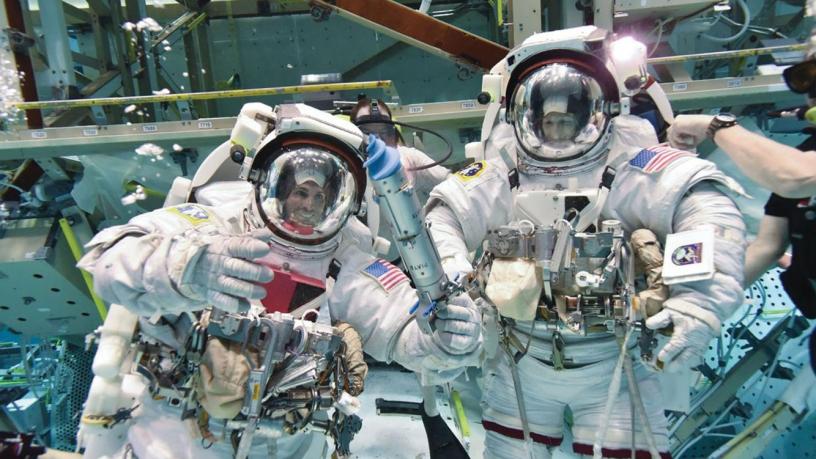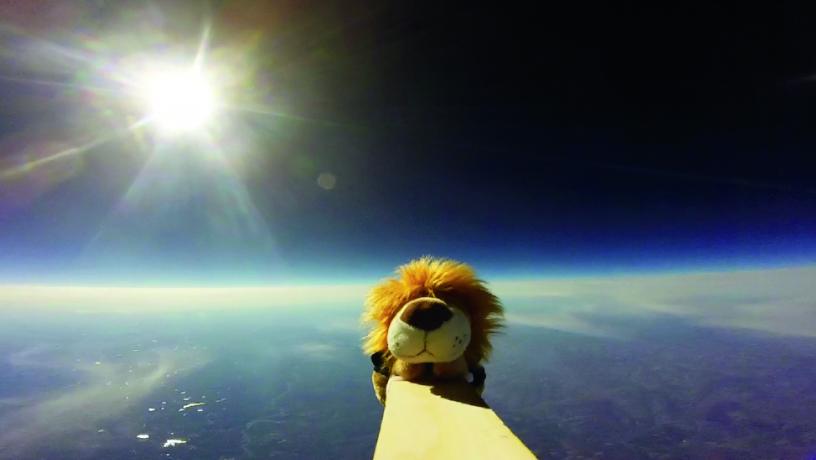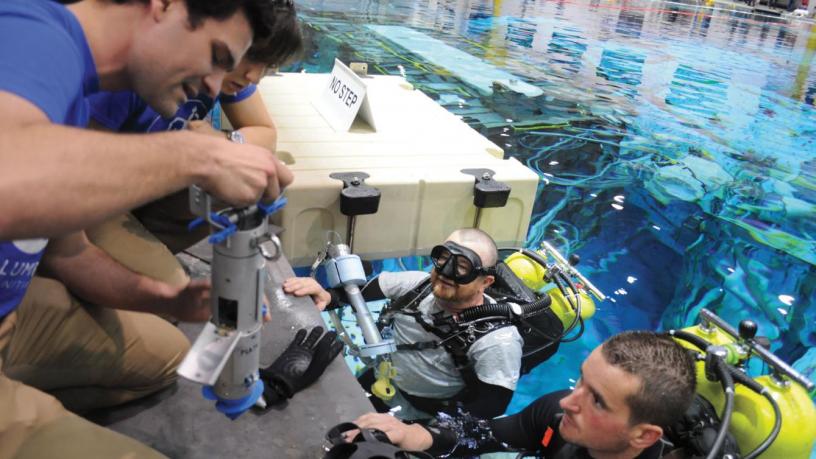Team Space: Columbia Space Initiative Takes Engineering to Extreme New Places
Columbia Space Initiative (CSI), one of Columbia’s newest student clubs dedicated to all things space and space tech, is less than a year old, but it’s already seen success: The group presented a design for an asteroid anchor at NASA’s Neutral Buoyancy Laboratory and competed at NASA’s prestigious RASC-AL (Revolutionary Aerospace Systems Concepts – Academic Linkage) competition.
Founded by Julia Di ’18SEAS and Keenan Albee ’17SEAS, the Columbia Space Initiative is “totally dedicated to space technology and outreach,” Di said. As an umbrella organization overseeing a number of projects—“We call them missions, because we’re a space club,” Albee said, laughing—the group has members working on a number of things. In April, one team planned and launched a high-altitude weather balloon.
Another team—one that counts both Di and Albee as members—went to Houston in May for NASA’s Micro-g NExT challenge to present their design for Lion Claw, a tool that anchors an astronaut to an asteroid and was created with input from former NASA astronaut and faculty adviser Michael Massimino, who has first-hand spacewalk experience. Massimino BS’84 is professor of professional practice in the Department of Mechanical Engineering and author of the just-released Spaceman: An Astronaut’s Unlikely Journey to Unlock the Secrets of the Universe.
Di and Albee said seeing the design they created in action in NASA’s Neutral Buoyancy Lab—a 6.2 million gallon diving tank that contains full-scale models of International Space Station modules and equipment for other space missions—was an amazing experience. (The group livestreamed it on Facebook.)
In the tank, Lion Claw held at least 30 pounds of force—triple the amount the design brief had called for.
“The divers who tested the tools said that ours was one of the strongest designs of the day,” Di remarked.
The CSI team, one of a small number of teams selected to test their astronaut tool designs in Houston, received grants from NASA, the Columbia College Student Council, the Columbia Engineering School Student Council, the SEAS Dean Travel Fund, and the Columbia Joint Council Co-Sponsorship Committee to work on their design and travel to Houston.
“We’re definitely planning to do the competition again this year,” Albee said.

Two test divers hold up the Lion Claw (Photo courtesy of Columbia Space Initiative)

Columbia mascot Roaree’s view from a high-altitude balloon that reached a peak height of 108,100 feet. (Photo courtesy of Columbia Space Initiative)

Jorge Orbay ‘17SEAS briefs one of the test divers at NASA’s Neutral Buoyancy Lab before CSI’s actual test session. (Photos courtesy of Columbia Space Initiative)
A separate team was selected to head to the Kennedy Space Center in Cape Canaveral, Florida, in June to present their proposal for a crewed mission to one of Mars’s moons as one of the 12 finalists in NASA and the National Institute of Aerospace’s RASC-AL competition for university students.
And these adventures are all thanks to the film The Martian.
While Di and Albee, friends through Columbia’s Formula SAE racing team, had separately been mulling the idea of starting a group that reflected their interest in space, the plan crystalized at a talk, held at the University last fall, centered on the Ridley Scott film.
The discussion, the inaugural event of the Engineering School’s Extreme Engineering program, featured clips from the film and discussion with Massimino and NASA engineers.
Extreme Engineering, spearheaded by Massimino and Dean Mary C. Boyce, brings in speakers who reflect the incredible diversity of cutting-edge careers available to engineering students. The School has already cohosted several events under the new Extreme Engineering banner and launched a video series, hosted by Massimino, that showcases faculty and their “extreme” research.
“We were looking for things that would excite the students—not just in space, but things that are very cool in the engineering space,” Massimino noted.
So far, it’s working: CSI is proof.
After the panel last September, Di and Albee said they approached Massimino to ask if he’d help them launch the club as their adviser, and with that the group was off and running.
“They’re out of control—they’re great,” Massimino remarked of the 30-strong club. “I’m amazed at everything they do. Truthfully, I just try to stay out of the way.”
Di and Albee say that CSI has cemented their commitment to pursuing careers in space exploration and technology. Over the summer, several CSI members held internships at NASA’s Jet Propulsion Laboratory, at Columbia’s Lamont-Doherty Earth Observatory, and at SpaceX. Albee worked on the CST-100 Starliner design team for Boeing’s Advanced Space Exploration group. Di interned at NASA’s Marshall Space Flight Center, as part of the NASA Robotics and Space Hardware Academy, working on building a robotic arm that can electrostatically capture orbital debris.
This academic year, Albee noted, the group will continue advocating for an aerospace major/minor program at the School and have started talking with the student council and faculty members about possibilities.
They’re also looking to expand CSI’s impact beyond Morningside.
“We’re working with other universities and trying to create a college consortium for space in the Northeast,” he said. “Things like that are pretty exciting.”
